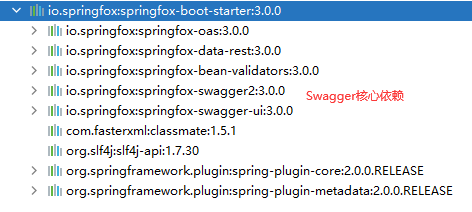一、Swagger简介
Swagger是什么
Swagger官网
关于swagger是什么的问题,swagger的首页说的再清楚不过:
Swagger is the world’s largest framework of API developer tools for the OpenAPI Specification(OAS), enabling development across the entire API lifecycle, from design and documentation, to test and deployment.
因为swagger庞大的生态系统,我们在api的整个生命周期中都能从中受益: from design and documentation, to test and deployment
前头我的easy-mock属于test部分,同时它也有效地帮助前后端分离
如果你想对Swagger有更深的了解,可以看下对Tony Tam的这段采访(Tony Tam影响了Swagger的诞生):通过Swagger进行API设计,与Tony Tam的一次对话
为何需要用它
如果你在为一个系统设计API,你希望更好的管理你的API,你希望有一个工具能一站式地解决API相关的所有事情,从设计到文档再到mock,甚至能直接从设计文档中生成代码(声明式编程),这确实是可能的,如果你的描述信息是完备的,自动化生成mock接口,同时也可生成各种语言与api交互的SDK
这些便是你选择Swagger的理由
特点
- 号称世界上最流行的API框架
- RestFul API文档在线自动生成工具 —> API文档与API定义同步更新
- 直接运行,可以在线测试API接口
- 支持多种语言(java、php)
二、快速入门—使用SpringBoot集成Swagger
1. 导入依赖
<!--Swagger相关依赖--><dependency><groupId>io.springfox</groupId><artifactId>springfox-boot-starter</artifactId><version>3.0.0</version></dependency>
2. 主启动类添加 @EnableOpenApi 注解开启Swagger2功能
@SpringBootApplication
@EnableOpenApi //开启Swagger功能
public class SwaggerApplication {
public static void main(String[] args) {
SpringApplication.run(SwaggerApplication.class, args);
}
}
3. 启动测试
页面访问:http://localhost:8080/swagger-ui/index.html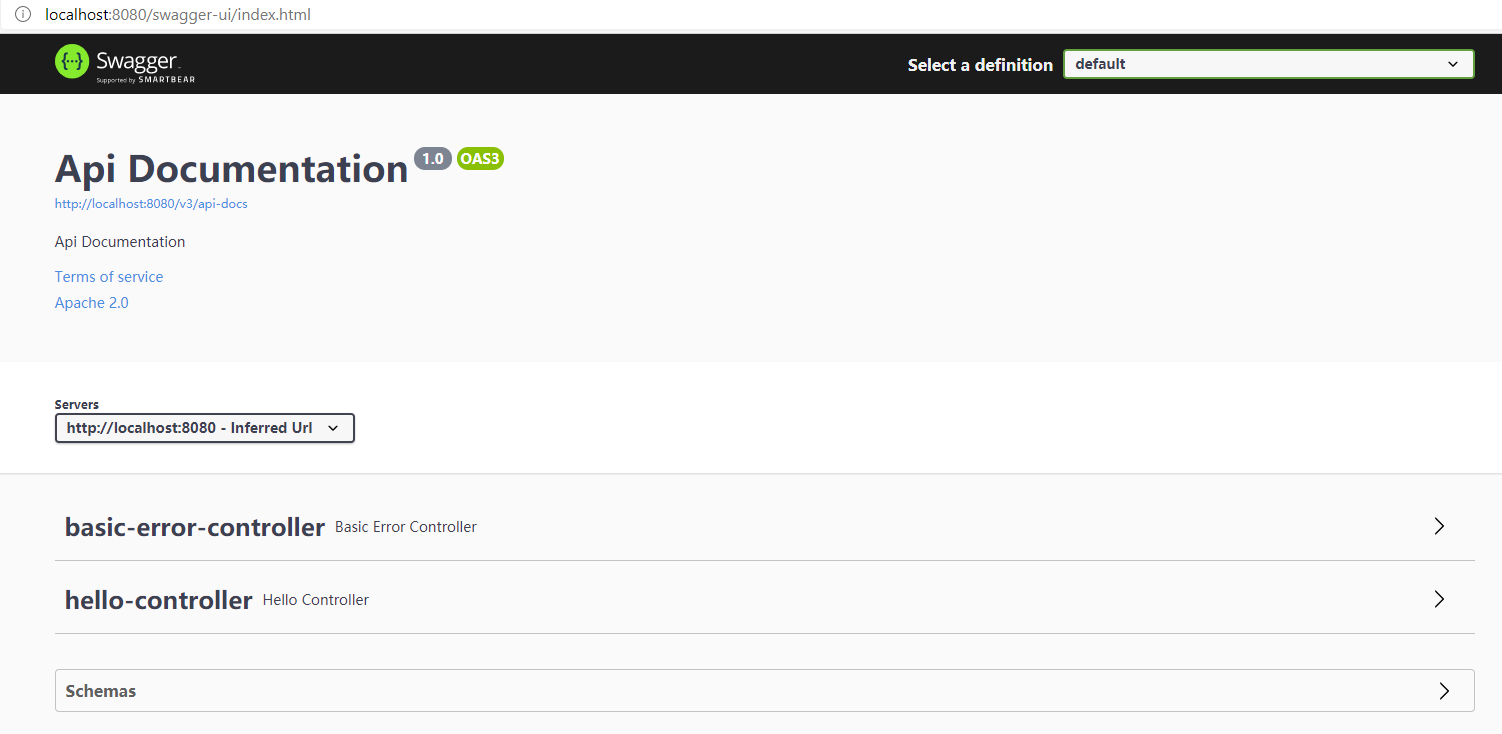
三、Swagger相关配置
1. 可以通过配置定制化Swagger首页
/**
* @className: SwaggerConfig
* @description 定制化Swagger
* @author GMF
* @date 2021/3/4
* @time 11:07
*/
@Configuration
public class SwaggerConfig {
//配置了Swagger的Docket Bean实例
@Bean
public Docket docket() {
return new Docket(DocumentationType.OAS_30).apiInfo(apiInfo());
}
//配置Swagger需要一个ApiInfo
@Bean
public ApiInfo apiInfo() {
//作者信息
Contact contact = new Contact("GMF","http://localhost:8080","2373271519@qq.com");
ApiInfo apiInfo = new ApiInfo("GMF Swagger Documentation", "没什么好笑的", "1.0", "urn:tos"
, contact, "Apache 2.0", "http://www.apache.org/licenses/LICENSE-2.0", new ArrayList());
return apiInfo;
}
}
Swagger相关配置源码Docket
public class Docket implements DocumentationPlugin {
public Docket(DocumentationType documentationType) {
//需要一个DocumentationType类型的参数
this.documentationType = documentationType;
}
}
Documentation
//Docket需要的参数类型
public class DocumentationType extends SimplePluginMetadata {
//其中已经内置了三个对象,直接使用即可
public static final DocumentationType SWAGGER_12 = new DocumentationType("swagger", "1.2");
public static final DocumentationType SWAGGER_2 = new DocumentationType("swagger", "2.0");
public static final DocumentationType OAS_30 = new DocumentationType("openApi", "3.0");
/** @deprecated */
@Deprecated
public static final DocumentationType SPRING_WEB = new DocumentationType("spring-web", "5.2");
private final MediaType mediaType;
public DocumentationType(String name, String version, MediaType mediaType) {
super(name, version);
this.mediaType = mediaType;
}
public DocumentationType(String name, String version) {
this(name, version, MediaType.APPLICATION_JSON);
}
public MediaType getMediaType() {
return this.mediaType;
}
public boolean equals(Object o) {
if (this == o) {
return true;
} else if (!(o instanceof DocumentationType)) {
return false;
} else if (!super.equals(o)) {
return false;
} else {
DocumentationType that = (DocumentationType)o;
return super.equals(that) && this.mediaType.equals(that.mediaType);
}
}
public int hashCode() {
int result = super.hashCode();
result = 31 * result + this.mediaType.hashCode();
return result;
}
}
ApiInfo
public class ApiInfo {
public static final Contact DEFAULT_CONTACT = new Contact("", "", "");
public static final ApiInfo DEFAULT;
private final String version;
private final String title;
private final String description;
private final String termsOfServiceUrl;
private final String license;
private final String licenseUrl;
private final Contact contact;
private final List<VendorExtension> vendorExtensions;
public ApiInfo(String title, String description, String version, String termsOfServiceUrl, Contact contact, String license, String licenseUrl, Collection<VendorExtension> vendorExtensions) {
this.title = title;
this.description = description;
this.version = version;
this.termsOfServiceUrl = termsOfServiceUrl;
this.contact = contact;
this.license = license;
this.licenseUrl = licenseUrl;
this.vendorExtensions = new ArrayList(vendorExtensions);
}
static {
DEFAULT = new ApiInfo("Api Documentation", "Api Documentation", "1.0", "urn:tos", DEFAULT_CONTACT, "Apache 2.0", "http://www.apache.org/licenses/LICENSE-2.0", new ArrayList());
}
...
}
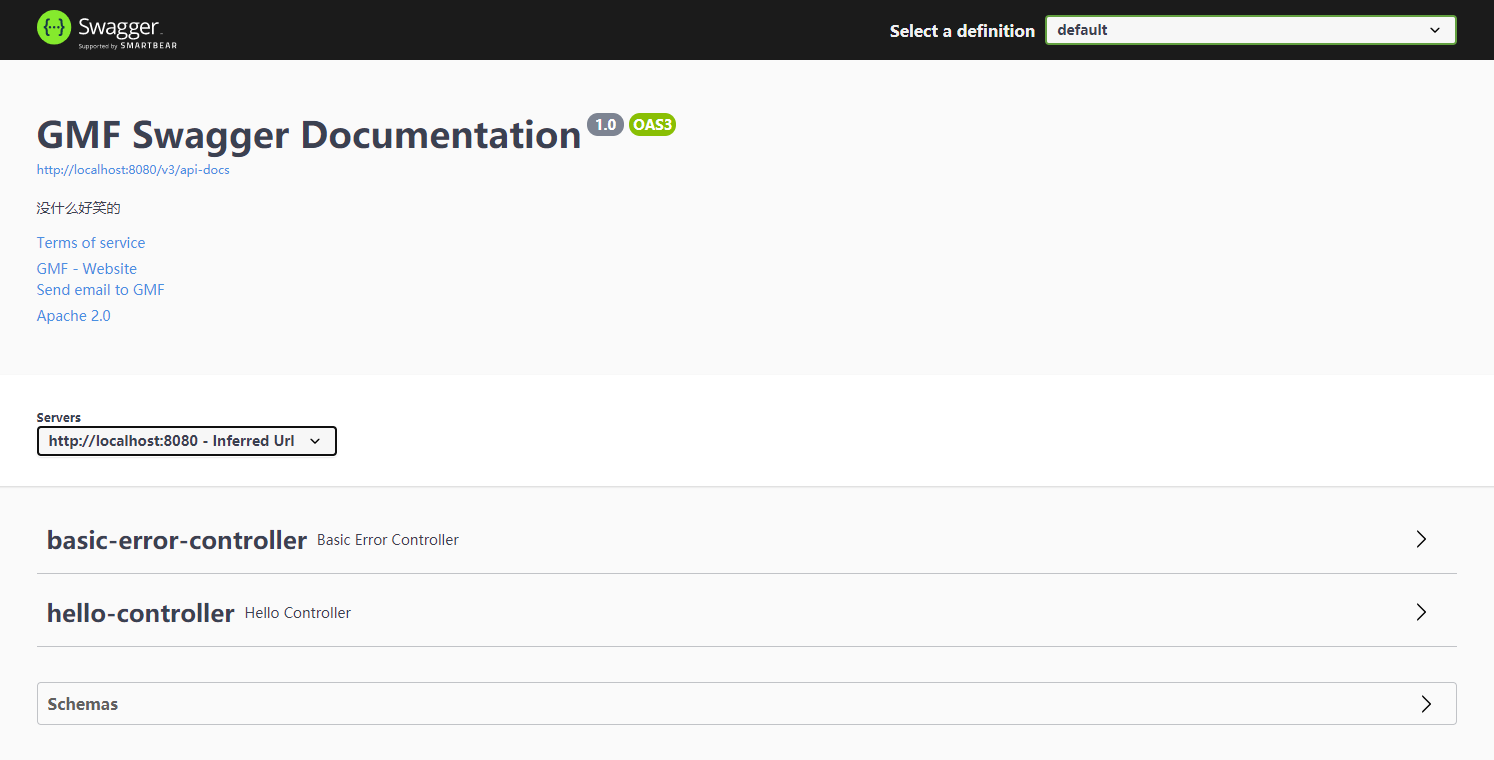
2. Swagger配置扫描接口
/**
* @className: SwaggerConfig
* @description 定制化Swagger
* @author GMF
* @date 2021/3/4
* @time 11:07
*/
@Configuration
@Slf4j
public class SwaggerConfig {
//查看当前Profile环境
@Value("${spring.profiles.active}")
private String profile;
//配置了Swagger的Docket Bean实例
@Bean
public Docket docket(Environment environment) {
log.info("当前的profile环境为{}",profile);
return new Docket(DocumentationType.OAS_30)
.apiInfo(apiInfo())
//获取API选择构建器,再次调用build方法返回构建文档
.select()
//RequestHandlerSelectors:配置要扫描接口的方式
//basePackage():指定要扫描的包
.apis(RequestHandlerSelectors.basePackage("com.gmf.controller"))
//指定要过滤的路径
//.paths(PathSelectors.ant("/gmf/**"))
.build(); //建造者模式
}
}
ApiSelectorBuilder
public class ApiSelectorBuilder {
//制定扫描接口的规则,使用时调用RequestHandlerSelectors类中的方法获取需要的参数
public ApiSelectorBuilder apis(Predicate<RequestHandler> selector) {
requestHandlerSelector = requestHandlerSelector.and(selector);
return this;
}
//指定要过滤的路径,调用时使用PathSelectors类中的方法获取需要的参数
public ApiSelectorBuilder paths(Predicate<String> selector) {
pathSelector = pathSelector.and(selector);
return this;
}
//返回一个构建文件Docket对象
public Docket build() {
return parent.selector(new ApiSelector(combine(requestHandlerSelector, pathSelector), pathSelector));
}
...
}
RequestHandlerSelectors
//制定扫描接口的规则
public class RequestHandlerSelectors {
private RequestHandlerSelectors() {
throw new UnsupportedOperationException();
}
//扫描所有接口
public static Predicate<RequestHandler> any() {
return (each) -> {
return true;
};
}
//不再扫描任何接口
public static Predicate<RequestHandler> none() {
return (each) -> {
return false;
};
}
//扫描方法上使用指定注解的接口
public static Predicate<RequestHandler> withMethodAnnotation(final Class<? extends Annotation> annotation) {
return (input) -> {
return input.isAnnotatedWith(annotation);
};
}
//扫描类上使用指定注解的接口
public static Predicate<RequestHandler> withClassAnnotation(final Class<? extends Annotation> annotation) {
return (input) -> {
return (Boolean)declaringClass(input).map(annotationPresent(annotation)).orElse(false);
};
}
private static Function<Class<?>, Boolean> annotationPresent(final Class<? extends Annotation> annotation) {
return (input) -> {
return input.isAnnotationPresent(annotation);
};
}
private static Function<Class<?>, Boolean> handlerPackage(final String basePackage) {
return (input) -> {
return ClassUtils.getPackageName(input).startsWith(basePackage);
};
}
//扫描指定包路径下的接口
public static Predicate<RequestHandler> basePackage(String basePackage) {
return (input) -> {
return (Boolean)declaringClass(input).map(handlerPackage(basePackage)).orElse(true);
};
}
private static Optional<Class<?>> declaringClass(RequestHandler input) {
return Optional.ofNullable(input.declaringClass());
}
}
PathSelectors
public class PathSelectors {
private PathSelectors() {
throw new UnsupportedOperationException();
}
//过滤全部
public static Predicate<String> any() {
return (each) -> {
return true;
};
}
//不再过滤
public static Predicate<String> none() {
return (each) -> {
return false;
};
}
//使用正则表达式过滤指定接口
public static Predicate<String> regex(final String pathRegex) {
return new Predicate<String>() {
public boolean test(String input) {
return input.matches(pathRegex);
}
};
}
//过滤指定路径过滤指定接口
public static Predicate<String> ant(final String antPattern) {
return new Predicate<String>() {
public boolean test(String input) {
AntPathMatcher matcher = new AntPathMatcher();
return matcher.match(antPattern, input);
}
};
}
}
3. Profile环境切换开启关闭Swagger
在Swagger默认配置类中,引入了SpringfoxConfigurationProperties类的配置
@Configuration
@EnableConfigurationProperties({SpringfoxConfigurationProperties.class})
@ConditionalOnProperty(
value = {"springfox.documentation.enabled"},
havingValue = "true",
matchIfMissing = true
)
@Import({OpenApiDocumentationConfiguration.class, SpringDataRestConfiguration.class, BeanValidatorPluginsConfiguration.class, Swagger2DocumentationConfiguration.class, SwaggerUiWebFluxConfiguration.class, SwaggerUiWebMvcConfiguration.class})
@AutoConfigureAfter({WebMvcAutoConfiguration.class, JacksonAutoConfiguration.class, HttpMessageConvertersAutoConfiguration.class, RepositoryRestMvcAutoConfiguration.class})
public class OpenApiAutoConfiguration {
public OpenApiAutoConfiguration() {
}
}
SpringfoxConfigurationProperties:Swagger相关配置
@ConfigurationProperties("springfox.documentation")
public class SpringfoxConfigurationProperties {
//开启Swagger功能
private boolean enabled = true;
...
}
建立不同环境下的配置文件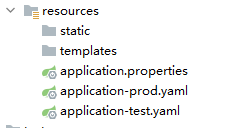
application-prod.yaml
#线上环境关闭Swagger
springfox:
documentation:
enabled: false
application-test.yaml
#开发环境开启Swagger功能
springfox:
documentation:
enabled: true
application.properties
#指定profile环境
spring.profiles.active=prod
测试线上环境Swagger运行情况
测试开发环境Swagger运行情况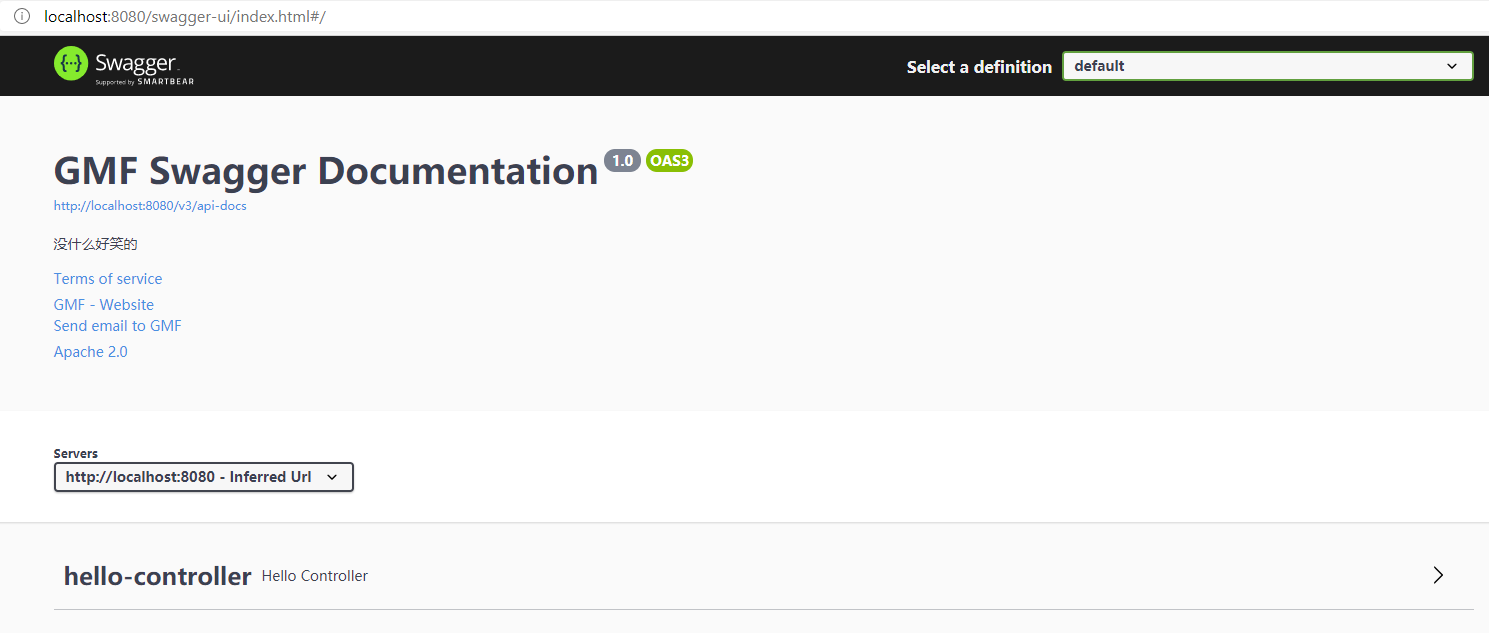
4. Swagger分组
在容器中添加多个Docket Bean
@Bean
public Docket docket1(){
return new Docket(DocumentationType.OAS_30).groupName("A");
}
@Bean
public Docket docket2(){
return new Docket(DocumentationType.OAS_30).groupName("B");
}
@Bean
public Docket docket3(){
return new Docket(DocumentationType.OAS_30).groupName("C");
}
出现了多个分组
5. Swagger对接口(Controlelr)的注释
如果需要在Swagger中显示Model实体,则需要将其添加到扫描的指定包下的Controller返回值中
Controller
@RestController
public class HelloController {
/**
* @param
* @return com.gmf.pojo.User
* @description 创建的实体只要在Controller中有返回,则会添加到Swagger的Model中
*/
@PostMapping("/user")
public User user(){
return new User();
}
}
pojo
import io.swagger.annotations.ApiModel;
import lombok.Data;
//标注实体在Swagger Model中的显示名称
@ApiModel("用户实体类")
@Data
public class User {
//标注实体属性在Swagger中显示的名称
@ApiModelProperty("用户名")
private String username;
@ApiModelProperty("密码")
private String password;
}

如果需要为接口(Controller)添加注释,在Swagger页面显示详细信息,则需要添加@ApiXxx注解
@RestController
@Api(tags = "Swagger接口测试") //标注Controller名称
public class HelloController {
@GetMapping("/hello")
public String hello(){
return "Hello";
}
/**
* @param
* @return com.gmf.pojo.User
* @description 创建的实体只要在Controller中有返回,则会添加到Swagger的Model中
*/
@PostMapping("/user")
public User user(){
return new User();
}
//标注每一个接口的名称
@ApiOperation("测试传递User参数的controller接口")
@PostMapping
//标注所需参数的名称
public User user(@ApiParam("参数传递的User实体") User user){
return user;
}
}
在Swagger页面显示了扫描包下的所有接口,并附带有注解的详细信息
更厉害之处在于,前端人员能直接进行接口测试,**极大的方便了前端与后端之间的沟通**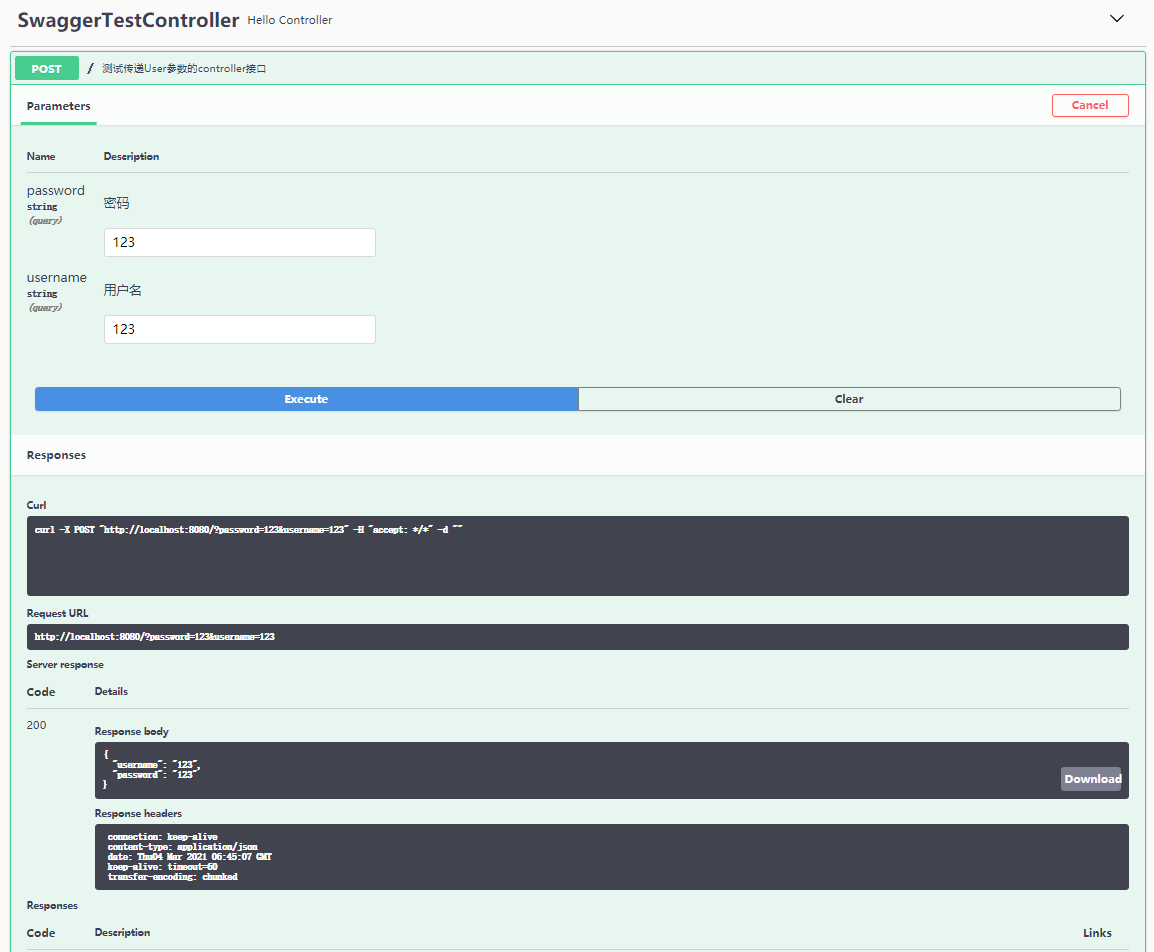
注意:在项目正式发布之前,关闭Swagger,出于安全考虑,并且减少内存占用
